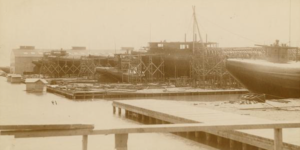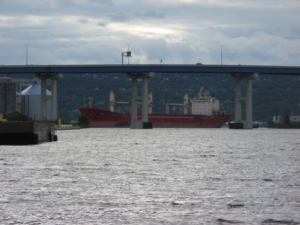
Off the coast of the Duluth-Superior industrial port, at the foot of the St. Louis River, lies Howards Bay — Lake Superior’s largest U.S. tributary.
And the Howards Bay Remediation Project is targeting the removal of more than a century of industrial pollutants left on the bay’s bottom.
The U.S. Environmental Protection Agency, Wisconsin Department of Natural Resources, and local entities collaborated in plans for removing lead, polycyclic aromatic hydrocarbons (PAHs), mercury, and tributyltin
and restoring Howards Bay, as part of the EPA’s St. Louis River Area of Concern. An AOC is “a location that has experienced environmental degradation.”
The St. Louis River AOC covers 179 miles of riverway from Cloquet, Wisc., through Jay Cooke State Park, to Superior, Wisc. and the headwaters of Lake Superior’s Howards Bay. The Howards Bay project will restore the waterways of three industrial slips — Fraser, Cumming Avenue and Hughitt.
According to the Superior Telegram, in March, the Superior City Council approved the $18.5-million partner agreement for the project’s post-design activities. The EPA’s Great Lakes Restorative Initiative (GLRI) dedicated $13.8 million.
Jason Serck, economic development, planning and port director for the City of Superior, explained that the federal funding was contingent upon non-federal entities contributing at least 35 percent of the cost. And the majority of the area’s contamination is lead from ships, he said.
To help fund the project, Fraser Shipyards Inc. stepped up as a major non-federal contributor, dedicating $2.2 million.

The shipyards in Howards Bay were busiest during wartime, Photo by Joe Graham WDNR via Illinois-Indiana Sea Grant
“They (shipyards) used to do a lot of blasting of the (ship) paint,” he said. “So that’s where most of the lead is. Of course, it’s just sitting there on the bottom, because lead doesn’t dissolve.”
The project’s design phase, which is about to wrap up, followed a remedial investigation phase, or “site characterization,” during which scientists collected sediment samples to determine pollution levels, type of pollutants and how they affect humans and marine life.
A feasibility study applied the data for planning clean-up activities and defining the bay’s Beneficial Use Impairments (BUIs) and local restoration targets.
Launching this era’s major Great Lakes restoration efforts, in 2002, the Great Lakes Legacy Act (GLLA) authorized the clean-up of 19 “Great Lakes Areas of Concern.” In 2012, the binational Great Lakes Water Quality Agreement (GLWQA) tackled the mammoth undertaking of restoring 43 AOCs in Canada and the United States, including the St. Louis River AOC.

Large ships can often be seen passing by Howards Bay into the harbor, Photo by Joe Graham WDNR via Illinois-Indiana Sea Grant
Serck said bid solicitation will go out this fall for the project’s start of work in 2020, adding the U.S. Army Corps of Engineers will manage dredging, dry excavation and capping of the project’s waterways and reuse of dredged material for the construction of environmentally safe recreation spaces.
“In addition to benefiting humans who use Howards Bay,” said Joe Graham, Lake Superior sediment and monitoring coordinator with the Wisconsin Department of Natural Resources, “the cleanup of contaminated sediments will improve habitat for fish and wildlife by eliminating exposure to potentially harmful chemicals. The DNR captured northern pike and musky in net surveys during spawning. The completed project will provide a cleaner environment for their young to grow up.”
“Improving the fishery in that area is a huge benefit,” said Serck. “But also the shipyards will benefit. This will allow them some expansion. … That’s another huge benefit for us for industry and employment. And with the reuse of the material, we’ll provide some additional recreation spaces for our residents.
“We’re really happy to see this project come to fruition.”
Featured Image: Howards Bay in the 1980s, Photo by Joe Graham WDNR via Illinois-Indiana Sea Grant




